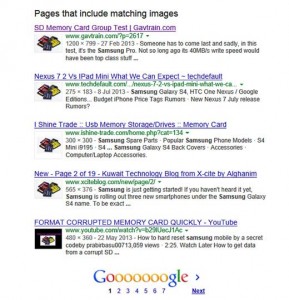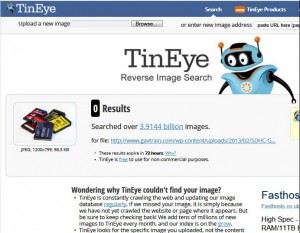Who’s stealing your photos?
 Warning! This blog post might cause annoyance and paranoia… but don’t let that stop you reading it!
Warning! This blog post might cause annoyance and paranoia… but don’t let that stop you reading it!
Thanks to the internet, image theft is on the rise and the harsh reality is there’s not much us photographers can do to stop it.
Don’t think for a second that it will only be your best work that’s at risk. Take a look at how many times my snap shot of a pile of memory cards has been used by others (all without my permission). It’s hardly a photo I’m ever going to print out but it’s probably my most stolen!
It’s not just photographers. In the past week I know of someone who found one of her photos published in a magazine without her knowledge. To be fair to the magazine, they were sent it by a reader who claimed it was there’s. Neither the owner of the photo nor the magazine is connected to photography.
Minimise the risk
Short of not uploading anything to the internet, what can you do to stop image theft?
Well, first off you could stop worrying about it. Everyday Facebook users add 300 million photos, so the chances of anyone stealing yours are mathematically very small. You might want to add a watermark to your images or add copyright metadata. Yes they can be easily removed but they can also act as a deterrent to the casual image thief.
There’s also the option for making you photos available with a Creative Commons licence allowing your images to be used in certain ways and not in others.
 Finding your Images
Finding your Images
So who’s using your images without permission? Well probably no one but there are ways to check with the help of a couple of websites. Here are two I’d recommend.
Google Reverse Image Search is like a backwards version of Google’s usual image search. Instead of find images that match words it finds images that match images and then tells you where they are. It’s quick, free and very accurate.
To find it go to Google’s Image search, click the camera icon and paste a link to an image you want to match. Alternatively you can upload a sample image.
The results are displayed just like any other Google search.
 TinEye has been around longer then Google but doesn’t have the reach of Google’s reverse image search. Just like Google you can search using an image that’s already online or upload your own.
TinEye has been around longer then Google but doesn’t have the reach of Google’s reverse image search. Just like Google you can search using an image that’s already online or upload your own.
One nice feature is the option to look at a whole webpage for images and you can choose which of those you want to search for.
TinEye doesn’t have the reach of Google but don’t rule it out. Sometimes if finds results Google misses.
What to do next
Hopefully the only pages using your photos are yours or pages you work with. However if you do find your images in use elsewhere there are a number of things you can do. Some of them involve legal action, not something I do lightly and beyond the scope of this post. However if the transgressor isn’t worth the time and stress legal recourse may require and all you want is the image taken down or credit given, then a polite but firm email often works wonders.





Hi Gavin! Many thanks for the information; didn’t know about these websites so I’ll be checking them out to see if any of my images have been stolen.
All the best
Hi Gavin, hope you are well. Thanks for the information, its horrible when you find out images have been stolen. i wonder how many people claim images used illegally which have been edited on a dodgy version of Photoshop…
Hi Gav, good call it’s even a struggle when you LEGALLY buy stock images that people without even thinking, accuse you of stealing them, I purchased two images from shutterstock to start my website going until I obtained my own, which is better in the long run but to start with is perfectly legal, according to the terms and conditions of shutterstock and then I had a Guy from another photography site, state that the image wasn’t mine even though i had not credited it myself in anyway, they were very hostile toward me & my facebook site, I just wonder if they were fearing competition in someway, which is sad really as pretty much every great photographer I have got to know, including yourself have welcomed other photographers like a community..still cant win them all I suppose 🙂 good article Gav, good to see your ahead of the game, and not to much of your work is being pinched.
The stock market is huge and unless you brought an exclusive licence the same image may appear on reverse image searches, even if they person wasn’t searching your site.
Using a stock image in a blog post shouldn’t get you any grief. I hope you fought your corner of that was the case.
Incidentally I would never recommend using stock on a portfolio page unless you make it very VERY clear it’s stock. That way leaves the photographer wide open to fake it till you make it buy fellow photographers and clients.
Oh yes definitely fought my corner, didn’t here nothing back from the guy guess he felt that I didn’t know much or New kid on the bloke maybe….:)
Quite right always best to have your own work, but can be annoying esp: when your trying to start off, still live and learn.
have good weekend.
Simon, you have to make it very clear on your website that this is a stock image that you bought otherwise people may think that you took it. It’s against the T & C of stock sites to pass things off as your own. If you didn’t make it clear that you didn’t take it, maybe that’s why the other photographer thought you were faking it.
It would have been helpful to explain in the article the changes to the law, which are imminent and which will make image theft simpler and easier to do. Copyrighting the metadata is key.
Thanks Ian. I avoided that topic for a few reasons but yes, here in the UK it’s a real concern.
For anyone concerned about it I’d urge them to Google the question and find someone who can give an opinion that would hold up legally.
The third pic I put in the google search and wouldn’t ya know it! Bam, on a website. But it does have my old watermark logo on it. I guess that’s ok for them to steal and use still?
Here is the site: http://www.tocadacotia.com/cultura/musica/como-jimi-hendrix-revolucionou-a-guitarra-em-woodstock
Mine is towards the bottom with the watermark MadamShutterfly
Thanks for the info Gavin…think I will see what else is out there of mine!
I’m not too happy about seeing this one of my niece in her tutu. And unfortunately it is on more than just this site:
http://www.dmsonlinestore.com/Mesh_Tulle_Net_fabrics_s/1477.htm
how dare they do this!!
Using an image without permission is never the right thing to do even if it’s watermarked / linked back to your site. I hope you get it sorted.
I keep getting, The URL doesn’t refer to an image, or the image is not publicly accessible. Weird.
Thanks Gavin (for that and everything you share with us)
I just found one of my picture on a site giving advices about marketing on the web (it is a photo of a spider on a web…) and it illustrates a page giving this advice : “always use original material, don’t steal from someone else blog”
That’s very poor indeed. I hope you get it sorted.